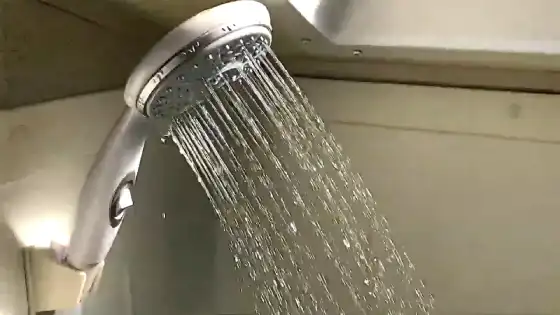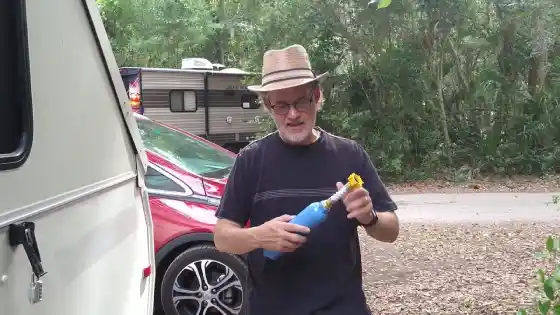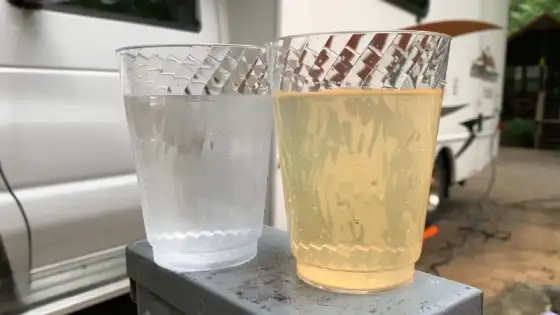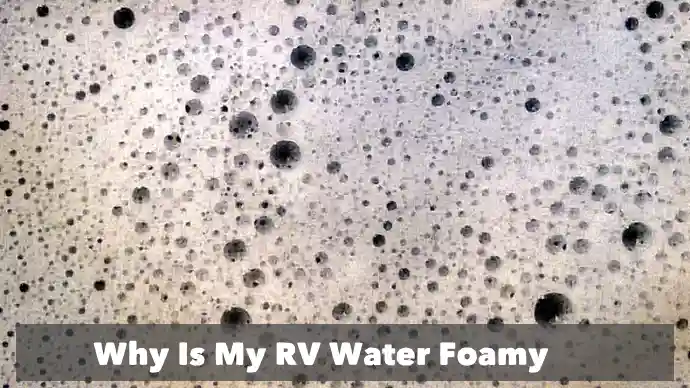Last Updated on December 24, 2023
Have you ever turned on the faucet in your RV and been met with a foamy stream of water? It can be a disconcerting and frustrating experience, leaving you wondering what could be causing this issue.
If you’re wondering why your RV water is foamy, there are a few possible causes to consider. Firstly, residual antifreeze could be the culprit, especially if you still need to thoroughly flush your system after winterizing.
Another potential cause is the hot water heater and bypass line, which can introduce air into the water and cause foaming. Additionally, the air in the water lines themselves or algae growth in your tank could also be to blame.
Understanding the root cause of the issue is essential in determining the appropriate solution and ensuring the safety and quality of your water supply. So, let’s dive into the causes of foamy water in your RV and what you can do to fix it.
Why Is My RV Water Foamy: Causes and Solutions

To make sure the quality and safety of your RV water, identify the cause of foamy RV water and fix it. Here’s what’s causing it:
- Residual Antifreeze
- Hot Water Heater and Bypass Line
- Air in the Water Lines
- Algae Growth
Let’s explore the cause in more detail:
1. Residual Antifreeze
To eliminate foamy water in your RV, it’s necessary to flush out any residual antifreeze from the water system thoroughly. Here are the steps to take:
- Drain the fresh water tank completely to remove any stagnant water and antifreeze residue.
- Run water through all the faucets and showerheads in your RV, including the hot and cold water taps, until the water runs clear.
- Flush the toilet multiple times to ensure the water in the bowl is clear.
- Refill the fresh water tank with clean water and repeat the flushing process until no more foam or residue is present in the water.
- Finally, sanitize the water system using a water and bleach solution, then rinse thoroughly.
It’s important to note that foamy water caused by residual antifreeze isn’t harmful to your health. However, it can be unpleasant to taste and may cause staining on surfaces.
2. Hot Water Heater and Bypass Line
Cleaning the hot water heater and bypass line can be a tedious process, but it’s worth it to ensure that the water coming from your faucet is clean and clear.
When cleaning the hot water heater, start by turning off the gas or electricity supply and letting the water cool down. Once it’s safe to handle, drain the water heater completely.
Refill the tank with freshwater and add a cleaning solution (such as vinegar or specialized cleaning products) before turning on the hot water supply. Let the solution sit for a few hours, then drain the tank again. Repeat the process until the water coming out of the tank is clean and free of residue.
When cleaning the bypass line, start by locating it and turning off the water supply to your RV. Remove the cover plate and disconnect the bypass valve. Flush the line with fresh water until no more antifreeze comes out.
Check for leaks by reconnecting the valve and cover plate, then turning on the water supply. You may need to repeat this process several times until the foaming issue is resolved.
3. Air in the Water Lines
You may be surprised to learn that the presence of air in your water lines could be causing the foamy water you’re experiencing. This can happen due to a loose connection or a broken filter screen in the water pump.
When air mixes with water, it creates foam, which can be very frustrating for RV owners. To address this issue, you need to check all connections and make sure they are tightly secured.
Additionally, inspecting and replacing any broken filter screens in the water pump can help prevent air from entering the water lines, reducing foaming.
4. Algae Growth
Did you know that algae growth in moist environments inside water lines can cause aerated water resulting in foam? This is why you might be experiencing foamy water in your RV.
Algae thrive in damp areas and can form slimy layers inside the pipes. When water flows through these algae-infested pipes, it can become aerated, resulting in foam.
To prevent this, it’s recommended that you periodically sanitize your RV’s water system. Using a chlorine bleach solution, thoroughly sanitize the water tanks and lines. Flushing the system multiple times after sanitization helps remove any chemical smell or foamy residue caused by the cleaning process.
Can using a water filter help eliminate foamy water in an RV?

RV water filters can help improve water quality, but they may not be the best solution for removing foam. A water filter is designed to remove impurities, such as sediment, chlorine, and bacteria, from the water supply. However, it does not specifically address the issue of foaming.
| Pros | Cons |
| Removes impurities from water supply | Does not specifically address foaming |
| Improves water quality | May not be the most effective solution for eliminating foamy water |
| Easy to install and use | Requires regular replacement of filter cartridges |
| Can be used for both drinking and bathing water | May not be sufficient for extremely polluted water sources |
Can hard water cause foamy water in your RV?
While a water filter can improve water quality, it may not necessarily eliminate foaming. However, using a water softener could help address this issue.
This is because hard water can contribute to mineral buildup and deposits in the water system, which can affect water clarity and quality. These mineral deposits can create a film on the surface of the water, leading to foaming.
To address this issue, regular maintenance is important. Flushing the system and using water softeners can help mitigate the effects of hard water and reduce the likelihood of foamy water in your RV.
How often should you replace the anode rod in your RV water heater to prevent foamy water?
You need to consider several factors when replacing the anode rod in your RV water heater. One of the most important factors is water quality.
If you are using hard water, which contains a high concentration of minerals such as calcium and magnesium, the anode rod will corrode more quickly and need to be replaced more often.
Usage patterns also play a role in the frequency of replacement. If you use your RV water heater frequently or for extended periods of time, you may need to replace the anode rod more frequently than someone who uses their RV occasionally.
As a general guideline, it is recommended to inspect the condition of the anode rod every one to three years and replace it when it has consumed more than 50%. However, this frequency may vary depending on your specific circumstances.
The table below provides a summary of the factors that can impact the lifespan of your anode rod and the recommended frequency of inspection and replacement.
| Factor | Impact on Anode Rod Lifespan | Recommended Frequency of Inspection and Replacement |
| Water Quality | Hard water can corrode anode rod more quickly | Inspect every 6 months, replace every 1-2 years |
| Usage Patterns | Frequent or extended use can accelerate corrosion | Inspect every 1-2 years, replace every 3-5 years |
| Anode Rod Material | Magnesium corrodes faster than aluminum | Inspect every 1-2 years, replace as needed |
| Tank Size | Larger tanks may require more frequent replacement | Inspect every 1-3 years, replace as needed |
Is it safe to drink foamy water from your RV?

Drinking foamy water from your RV may pose health risks due to potential contaminants or residues present in the water. While the foam itself may not necessarily be harmful, it is an indication that there may be issues within your RV’s water system.
It is difficult to determine the exact cause of the foam without proper testing, but it could be a result of residual antifreeze, algae growth, or other factors.
To ensure your health and safety, it’s advisable to avoid consuming foamy water and instead use alternative sources such as bottled water for drinking and cooking purposes.
Consuming foamy water can lead to a range of health issues such as stomach upset, diarrhea, and vomiting. In addition, consuming contaminated water can cause more serious illnesses such as hepatitis A, giardia, or cryptosporidium.
How do you make your RV water safe to drink?
If you’re looking to make your RV water safe to drink, there are a few steps you can take. First, make sure to use a dedicated drinking water hose that’s made specifically for potable water to prevent contamination.
You can also improve the quality of the water by installing a permanent water filter system designed to handle the unique challenges of RV water systems.
Another option is to install a separate faucet that’s solely dedicated to drinking water and has a carbon filter for further purification.
For an additional layer of purification, consider using a reverse osmosis water filtration system that removes contaminants like bacteria, viruses, and chemicals from the water.
How often should you sanitize your RV water system?
It is generally recommended to sanitize your RV water system at least every six months. Regardless of how frequently you use the water or the manner in which it is used, regular sanitization helps ensure that the water system remains clean, free from bacteria, and safe for consumption.
By sanitizing the water tank and lines, you can eliminate any potential buildup of contaminants, biofilm, or bacteria that may develop over time.
It is important to follow the manufacturer’s guidelines or consult your RV’s manual for specific instructions on how to sanitize your particular water system properly.
Additionally, if you notice any unusual odors, discoloration, or other signs of water contamination, it is recommended to sanitize the system immediately, regardless of the regular sanitization schedule.
How long can water sit in an RV fresh water tank?
If you are not using the water in your RV and not refilling the tank during that time, it is generally recommended not to let water sit in the freshwater tank for more than two weeks.
Allowing water to sit stagnant for extended periods can lead to the growth of bacteria, algae, and other contaminants. To maintain water quality and prevent potential health risks, it’s advisable to use and refill the freshwater tank regularly.
If you anticipate long periods of inactivity, consider draining the tank and flushing the system before storing your RV to minimize the chances of water stagnation and ensure a fresh water supply for future use.
Say Goodbye to Foamy Water in Your RV
Foamy water in your RV can be caused by residual antifreeze, the air in the water lines, algae growth, or hot water heater issues.
Regular maintenance and flushing of your RV’s water system, along with the use of filters and replacement of anode rods, can prevent these issues and ensure clean, clear water for you and your family.
Don’t let foamy water ruin your RV adventures. Take the necessary steps to maintain your water system and enjoy fresh, safe water on all your trips.



